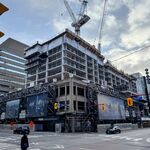ARG1
Senior Member
15m is the maximum time a bus is considered frequent. Its the frequency that Toronto uses as a baseline for arterial bus services. This is fairly standard all things consideredI certainly do not think so. If I had an alternative option, I would never wait 15 minutes for a bus. For me, 12 is the absolute longest I'm willing to wait for local public transit.
15m is very much within the ball park of show up and wait without needing to schedule. However, it is the limit.GO is different, because one typically makes an appointment to be at the station for a certain departure. But in local transit settings, with a lot of people making spur of the moment ridership decisions, 15 minutes is a repulsively bad frequency.
I mean sure, but I congratulate you on completely avoiding the point I was making. Again, local busses is just 1 part of the solution, proper bike infrastructure is also a major factor that should help with last mile connections.I am not aware of any line with an express service, where the local service runs every 15-30 minutes, with the one exception of the 45, which is supplemented by the 945 running local north of Belfield. The lines served by expresses have good local frequencies, as well. This would not be a case of local and express complementing each other, it would be a case of the express hogging all the resources and the local being thrown a half chewed bone just so that it can be said that it is not completely neglected.
Christie, Greenwood, even Castle Frank honestly (unless they build the Parliament Streetcar up to it, which would be pretty sweet).And which stations are those? Aside from possibly Chester.
First, I agreed that there should probably be infill stations between York Mills, Lawrence, and Eglinton.Why is that? If the Yonge line is only useful for the people who live close to its far apart stations, or those who live along a bus line that terminates at one of those stations, how could it be considered democratic? Big stretches of Yonge Street only have a bus that runs every 25-30 minutes. For them, the Yonge subway may as well not exist.
Second, last I checked a few years ago the 97 ran every 15m. If that's no longer the case then I agree that's pretty bad.
Third, The vast, VAST majority of the people that use the Yonge Subway transfer from a bus service. Stations like Rosedale that only serve local streets and neighbourhoods comparatively generate a minuscule amount of ridership. Best case scenerio you have a station like North York Centre which is in the middle of a dense urban neighbourhood, but even then the amount of ridership that NYC gets is comparable to York Mills, which is basically in the middle of nowhere.
And I'm sorry, but a system that properly serves the majority of the stakeholders is by definition democratic. Making compromises for the majority of users in favour of a comparably smaller minority is by definition anti-democratic.
Go ahead, look at the ridership statistics for Line 1 Stations. I'll wait.Do they? I would think the stretches of Eglinton not within short distance of a major arterial are much more than the ones that are.
Yes, but now consider the collective time saved by the majority of people who live next to the station (assuming proper urban development) or connect to the line by bus, versus the time saved by the relative minority of people who use the local stops.I wasn't referring to walking speed, I was referring to the added time that the extra stops would add to your trip. If you nixed the Ionview, Hakimi Lebovic, and Aga Khan stops, the time savings would be much less than 5 minutes.
If the average loading time at each of those 3 stops was 40 seconds (which is a generous estimate incorporating braking and acceleration speeds), that means that if those 3 stops were axed, you would save a whopping 2 minutes.
If 2 minutes of extra travel time is the difference between a rapid transit line and a streetcar line, I think we have bigger problems here. And:
Its the same principle as transit vs the car. Adding priority measures to improve the performance and travel time of transit vehicles will often negatively impact the travel time of the car. At the same time though, the 70 people on the bus or heck even 200 people on an LRV should probably have the priority over the 30 or so cars waiting for the light.
You know what? I agree. It is a selfish view. That's why we should under no circumstances take away car lanes in favour of transit priority lanes. The people taking transit are simply selfish for thinking they have the right to save time in comparison to the fewer people who use the car.If the majority of people balk at having their trip take a couple of minutes extra, for the benefit of many other people, it is still a selfish view. Selfish and foolish views do not stop being so if the majority subscribe to them.
... see how ridiculous that sounds?





